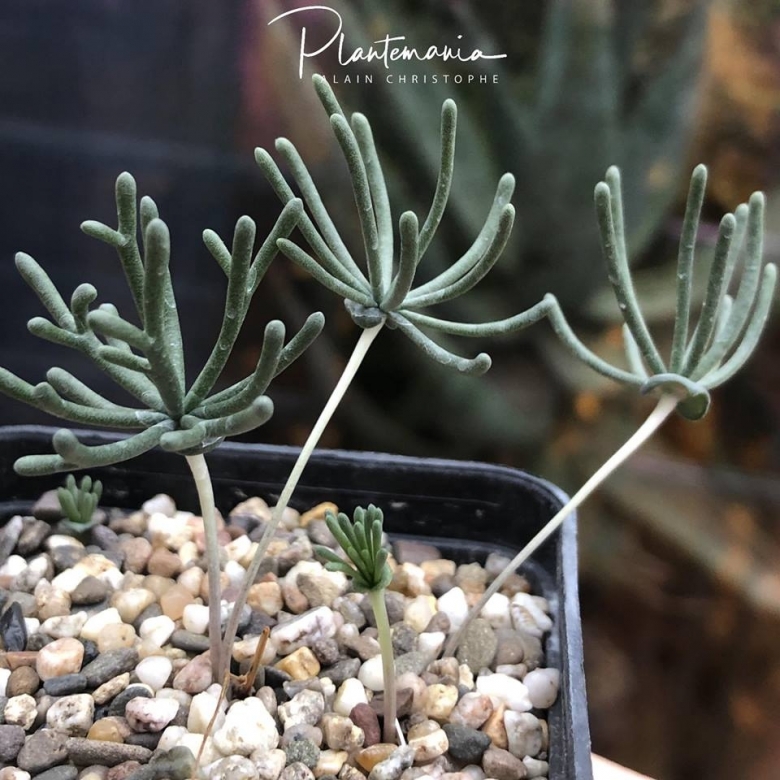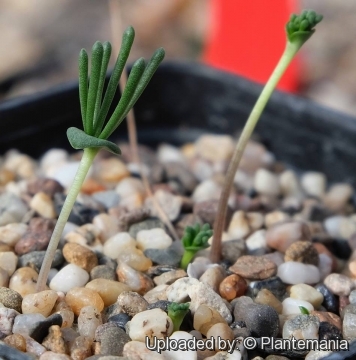
Eriospermum bowieanum Photo by: © Plantemania
Origin and Habitat: Eriospermum bowieanumSN|34492]]SN|34492]] is endemic to the Worcester Karoo (Worcester to Ashton), Western Cape, South Africa. Extent of occurrence 2500 km2. There are probably less than 10 locations although only four are known.
Habitat and Ecology: Breede Shale Renosterveld, Breede Alluvium Fynbos. Eriospermum bowieanumSN|34492]]SN|34492]] grows in semi-arid regions on stony flats and lower slopes, on clayey soils, amongst low karroid bushes. Itis autumn-flowering. This species is severely threatened by wheat and vineyard expansion. It is also threatened by invasive alien species (direct effects) and by habitat loss. The population trend is decreasing.
Synonyms:
See all synonyms of Eriospermum bowieanum
back
Accepted name in llifle Database:Eriospermum bowieanum BakerJ. Linn. Soc., Bot. 15: 267 1876.Synonymy: 2
back
Description: Eriospermum bowieanumSN|34492]]SN|34492]] is a bizarre succulent plant with a small solitary, hysteranthous leaf (that expands after the flowers have opened) with club-shaped appendages above. The inflorescence is spicate with small globose-like greenish flowers.
Tuber: Large, simple and unlobed, succulent, irregular-globose to oblong, up to 5.5 cm long, and 3.8 cm in diameter. Skin light brown, interior pink to maroon red. Old leaf sheaths spreading near ground level, membranous, greyish-brown. Most plants grow not from the top of the tuber, but from the side or from the bottom.
Leaf: Hysteranthous, solitary, small, erect or suberect. Petiole (leaf sheath) to 4 cm long, exserted up to 40 mm, 3 mm diameter, pinkish at the extreme base, white above, glabrous. Lamina cordate-ovate, bluish, glabrous, 10-12 mm long and wide, margin revolute, the face covered with linear, clavate (club-shaped), simple or branched, processes 6-50 mm long, erect, glabrous, arising in a cluster from the base of the lamina.
Inflorescence. Peduncle 2.5-4 cm long, wiry. Raceme dense, spicate to subspicate, to 3 cm long and 13 mm wide, 5?20-flowered. Bracts triangular, up to 2 mm long, membra.11ous, white with a reddish-brown midvein. Pedicels 1.0-1.5 mm long.
Flowers: Small globose, spreading up to 7 mm across. Perianth 3-4 mm long. Segments (tepals) dimorphic, connate at the base only, oblong, white with green midvein keeled with purple.Outer segments lanceolate, 5 mm long 1.8 mm wide, inner segments widening to apex, 4 mm long, 2.3 mm wide. Stamens shorter than the perianth; filaments lanceolate fused to base of tepals, lanceolate; anthers yellow. Ovary ball-shaped, 1.3 mm in diameter. Style 1.5 mm long, white.
Bibliography: Major references and further lectures
1) J. G. Baker "Flora Capensis", 1897
2) Urs Eggli, "Illustrated Handbook of Succulent Plants: Monocotyledons", Springer Science & Business Media, 06 December 2012
3) Goldblatt, P. and Manning, J.C. 2000. "Cape Plants: A conspectus of the Cape Flora of South Africa". Strelitzia 9. National Botanical Institute, Cape Town.
4) Perry, P.L. 1994. "A revision of the genus Eriospermum (Eriospermaceae)" Contributions from the Bolus Herbarium 17:1-320.
5) Raimondo, D., von Staden, L., Foden, W., Victor, J.E., Helme, N.A., Turner, R.C., Kamundi, D.A. and Manyama, P.A. 2009. "Red List of South African Plants". Strelitzia 25. South African National Biodiversity Institute, Pretoria.
6) Helme, N.A. 2006. Eriospermum bowieanum Baker. National Assessment: Red List of South African Plants version 2017.1. Accessed on 2017/09/17
7) Eriospermum bowieanum in: The Journal of South African Botany: Supplementary volume, 13rd Edition, Trustees of the National Botanic Gardens of South Africa, 1984
8) eMonocot Team "Classification Nolinoideae" http://nolinoideae.e-monocot.org/taxonomy/term/1773 (accessed 18 September 2017)
 Eriospermum bowieanum Photo by: © Plantemania
Eriospermum bowieanum Photo by: © PlantemaniaSend a photo of this plant.The gallery now contains thousands of pictures, however it is possible to do even more. We are, of course, seeking photos of species not yet shown in the gallery but not only that, we are also looking for better pictures than those already present.
Read More...











